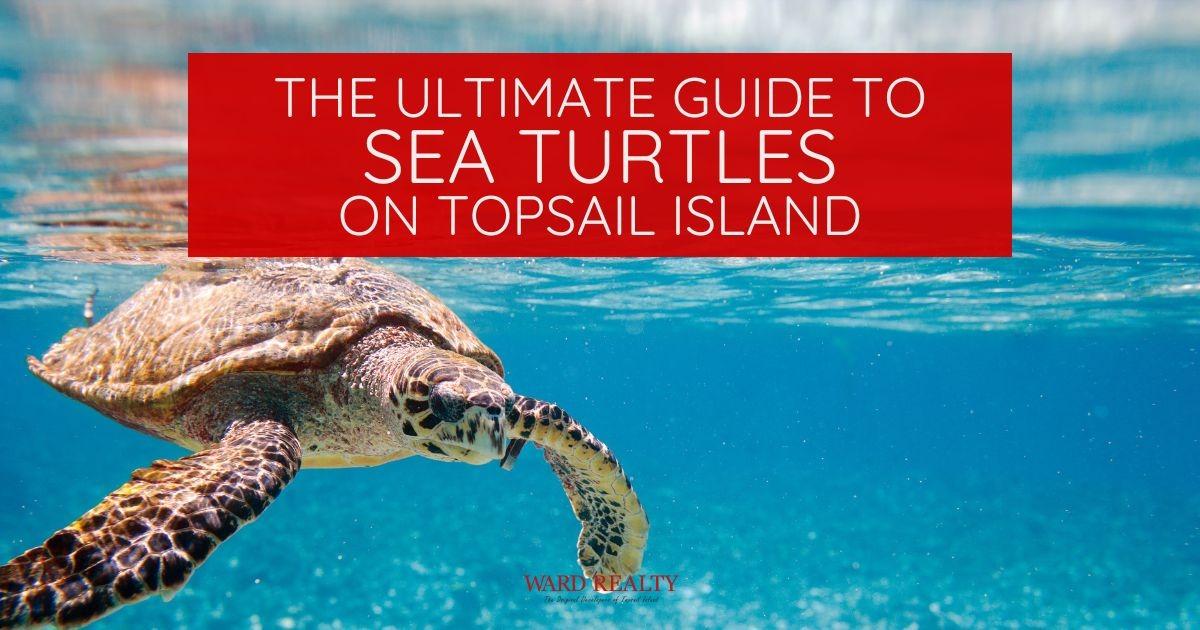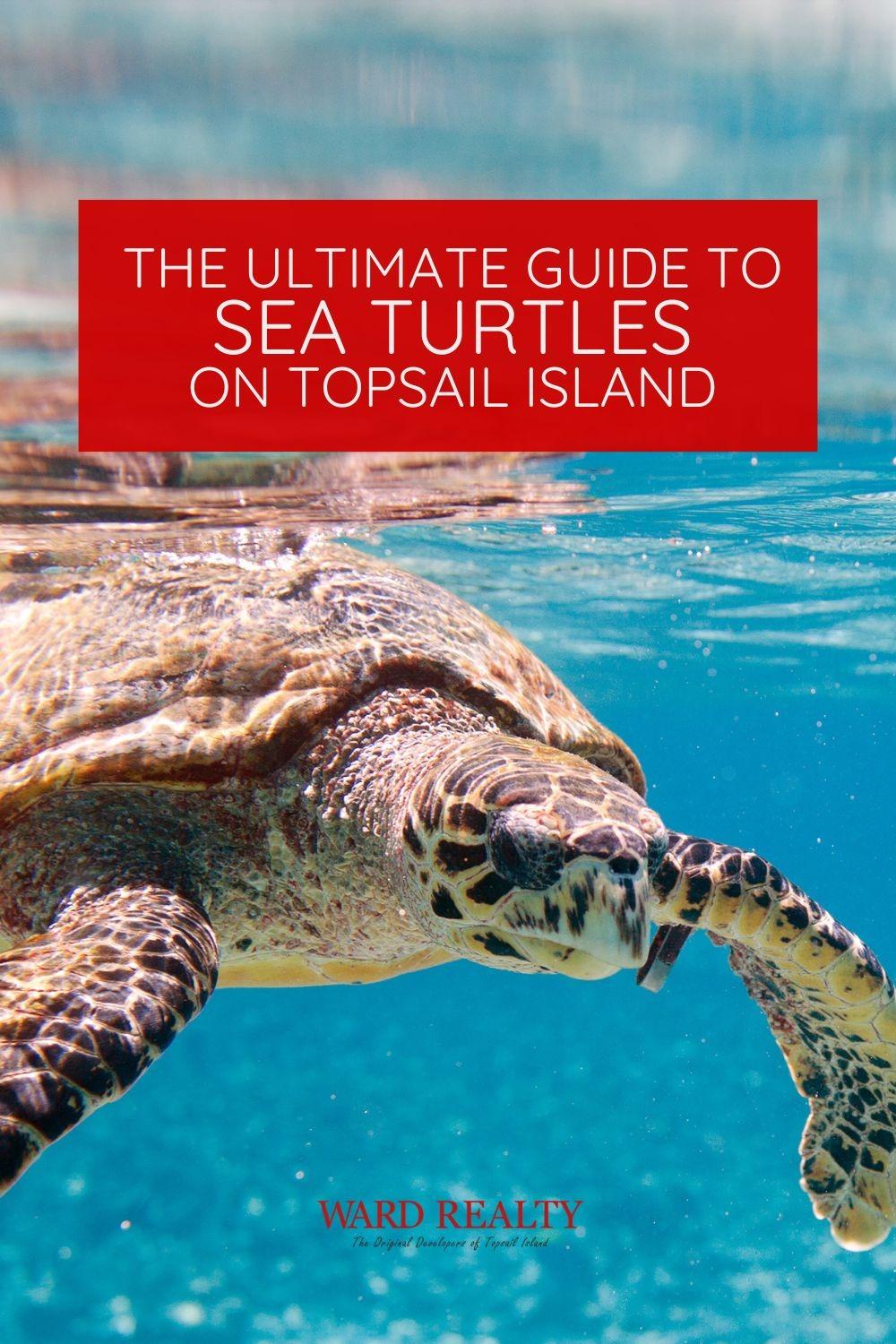
Did you know that when you vacation on Topsail Island, you are also visiting a sea turtle sanctuary? The sea turtles that inhabit the waters and beaches in and around Topsail Island and Surf City include green, leatherback, hawksbill, and loggerhead turtles. On some occasions, Kemp's ridley sea turtle nests have also been seen on Topsail Island. The Kemp's Ridley sea turtle is one of the rarest and critically endangered sea turtles.
Topsail Island, off the coast of North Carolina, is a nesting ground for these sea turtles. During their nesting year, they come ashore to lay their eggs between three and five times.
Facts About Sea Turtles on Topsail Island
Sea turtles are one of the oldest living species on this planet. In fact, scientists have discovered a sea turtle fossil that dates back 120 million years. Although the species once roamed the world's oceans in large numbers, increased human demand for their meat, skin, and eggs has caused the sea turtle population to dwindle over the past 100 years.
Sea turtles inhabit tropical and subtropical waters worldwide. Their torso consists of a hard upper jacket called the carapace and a soft lower section called the plastron. You may also be surprised to learn that sea turtles do not have teeth. However, their beak-like jaws and long necks can create a strong force to snap their prey and eat their food.
Sea turtles come in all sorts of colors, shapes, and sizes. For example, the olive ridley species commonly weigh less than 100 pounds. In comparison, a leatherback sea turtle can weigh up to a colossal 1300 pounds!
With the human race occupying vast landscapes and increasing environmental pollution, this species is finding it more challenging than ever before to survive and thrive. There could even come a time when this beautiful traveler of the sea is hard to find in the natural world and may instead wind up as simply an attraction in aquariums.
Nesting Season for Sea Turtles on Topsail Island
Sea turtle nesting season on Topsail's beaches runs from May through October, which also happens to be during the prime tourist season. Did you know that female sea turtles return to their beach of birth to lay their clutch of eggs, no matter how far away they may be?
The first challenge for the mother sea turtle is finding a suitable area to protect her eggs in the sand until the hatchlings emerge. Female sea turtles lay their eggs in a batch of around 100 eggs in each nest. The young will hatch in about 60 days if the nest remains undisturbed.
An average of 775 sea turtle nests Topsail Island are dug by nesting female sea turtles on the shores of North Carolina each year. All sea turtles that nest in the U.S. are either listed as threatened or endangered, and there are penalties for killing, harassing, or harming these turtles. So it goes without saying that we take sea turtle protection very seriously in Topsail.
The second challenge for the hatchlings to survive is to make their way to the water. These tiny animals only weigh a couple of ounces at birth, making them vulnerable to predators such as ghost crabs, birds, or fish.
Hatchling sea turtles on Topsail Island navigate by using the moon's light to guide their way. The people working to preserve the nests of sea turtles on Topsail Island advise tourists and homeowners not to use bright lights and to keep curtains drawn at night during nesting season because hatchlings may confuse the brightness from artificial equipment with moonlight. This may cause the hatchlings to travel in a direction away from the water, a scenario that will almost certainly prove fatal to the tiny creatures.
Protecting Nests, Eggs & Hatchlings On Topsail Island
Did you know that six of the seven species of sea turtles are classified as threatened or endangered, primarily due to human influence and lifestyle? That's a sad but true fact and the main reason why Topsail Island takes great care to protect its sea turtle population during nesting season and all throughout the year.
Karen Beasley Sea Turtle Rescue & Rehabilitation Center
Located on Topsail Island in Surf City and powered by incredible volunteers, the Karen Beasley Sea Turtle Rescue and Rehabilitation Center is one of our area's best sea turtle protectors and local resources. You can visit and see the patients yourself!
This facility was the brainchild of a young girl who, one night, saw a mother sea turtle make her way to the beach, lay her eggs, and disappear back into the ocean. The little girl stood near the nest the whole night to protect the eggs, and the next day, she determined to protect this species from harm. That young girl was Karen Beasley.
All donations to the sea turtle hospital go directly toward food, medical expenses, and operating costs since it receives no federal or state funding. Just be sure to check their days and hours of operation before you plan your visit. It's a must-see stop during your Topsail beach vacation.
If you can't get there in person, check out the website to see what they do daily to help nurture and protect Topsail Island's sea turtles. You'll be amazed!
Preservation Efforts
Every day, volunteers passionate about preserving sea turtles on Topsail Island patrol the twenty-six miles of the beach, ensuring that the nests are protected and unharmed. When the hatching time is near, the volunteers clear the area between the nests and the water so the hatchlings can easily reach their destination and start their journeys. Volunteers look for holes to cover, seaweed to clear, and remove any trash in the vicinity.
Throughout the years, environmentalists have established many projects to protect the sea turtles of Topsail Island.
North Carolina Sea Turtle Project
The North Carolina Sea Turtle Project is a wonderful resource run by the North Carolina Wildlife Commission's Division of Wildlife Management. They are committed to monitoring coastal Carolina's sea turtle population with the help of many volunteers, agencies, and statewide organizations. The NC Sea Turtle Project was created to monitor sea turtle activity along the entire coast of North Carolina, with sea turtle biologists working to recruit and train volunteers as well as others that participate in the project, including the Fish and Wildlife Service, the National Park Service, and various State Parks/Recreation Areas. Talk about teamwork!
The North Carolina Sea Turtle Project monitors and records nests, eggs, and hatchings. It also monitors, intervenes in, and assists with sea turtle strandings.
Topsail Island Residents, Visitors & Vacationers
We'd be remiss not to mention one of our best resources: YOU. Our local residents, visitors, and vacationers are crucial to the success of the sea turtle population. Not only do we have many tireless volunteers roaming our beaches and shorelines every year during nesting season on Topsail Island, but the cooperation of those who choose to visit and vacation on Topsail Island also makes a huge difference.
So what can visitors, vacationers, and residents do to help protect nesting sea turtles, their eggs, and the emerging hatchlings? A lot!
Help Protect Our Topsail Sea Turtle Population
Turn off visible lights.
Any artificial lighting near the beach, such as light from your oceanfront beach rental, can confuse our sea turtles. Turn off porch lights, close your curtains, and keep your property as dark as possible at night. Sea turtle hatchlings use light and reflections from the moon to find their way to the water at night, so we want to keep them headed in the right direction.
Clean up trash on Topsail's beaches.
Whether it's your trash or someone else's, cleaning it up is crucial to keeping our sea turtles safe and healthy. Sea turtles often become tangled in plastic and waste. Discarded items such as fishing lines, hooks, netting, balloons, and plastic bags may also be confused for favorite foods like jellyfish and eaten by sea turtles, often resulting in injury or death.
Clean up after your day at the beach.
Don't leave toys, chairs, and other obstacles out that could cause problems for nesting sea turtles or hatchlings. They don't need any additional stumbling blocks to overcome on their journey. They need a clear path from the sand to the ocean with as little distraction and disturbance as possible.
Be aware of sea turtle nests and keep your distance.
Be mindful of sea turtle nests and keep your distance, obeying roped-off or "off-limits" areas. Avoid disturbing nesting females and nesting areas by giving them space and refraining from using flashlights or getting too close. Keep dogs on leashes, and ensure young children understand and know the legal protections for sea turtles.
Limit your chemical use.
The chemicals you use on your lawn and home can wash into the ocean and waterways, killing plants and animals. It is essential to properly dispose of toxic chemicals and, even better, find alternative products such as biodegradable solutions.
Volunteer your time.
Get involved by volunteering your time to help sea turtles on Topsail Island. You can organize beach clean-up days, give presentations to educate others and advocate for their protection. If you're on Topsail Island long-term, consider becoming a sea turtle volunteer. Opportunities include:
- Monitoring beach sections for tracks and nests.
- Guarding nests during hatching season.
- Responding to strandings.
- Transporting injured turtles to rehabilitation centers.
Respect The Coastal Environment And Be Mindful Of Your Surroundings.
Being mindful is important, especially regarding natural elements. Pay close attention to what's around you while you're on the beach and leave it looking as good, if not better, than when you arrived.
Fill in any holes you dug before leaving the beach for the day.
Not only are they troublesome for people strolling the beach, but they are especially dangerous for nesting females and hatchlings.
Don't Disturb Nesting Sea Turtles And Report Any Sea Turtle Activity.
It's essential to keep your distance from sea turtle nests and not disturb nesting females or their clutch of eggs. If you see marked nests, it's OK to look, but please don't disturb them in any way. If you see an unmarked nest or any sea turtle activity, it's helpful to report it to the local sea turtle monitoring and protective organizations.
Report Sea Turtle Activity
If you spot any sea turtle activity, report it promptly. Urgently report sick or injured turtles needing immediate care, and stranded turtles should be tended to promptly. Call the N.C. Sea Turtle Project pager number at (252) 247-8117 and await a return call. Information on nesting females, turtle tracks, or hatching events is appreciated; call (252) 728-1528 or use the pager number. Sightings of healthy sea turtles in the water are also valuable to biologists. They can be reported by phone or email (252-728-1528, matt.godfrey@ncwildlife.org).
Did this article teach you something about sea turtles? If so, please share it on social media and help others learn about them!
Stay in a Beautiful Vacation Rental Right on the Beach
If you're excited about the sea turtles on Topsail Island and looking for the perfect place to stay, check out our gorgeous beach rentals. We offer many ideal spots across the island, all with unique views, amenities, and fully equipped kitchens to make your stay magnificent. Sit back and take in the view from the porch of your home away from home.
Check availability and book your stay today for your premier vacation of the year!

If you loved this article, share it with others who would love to learn more about sea turtles!




